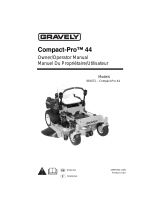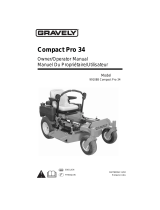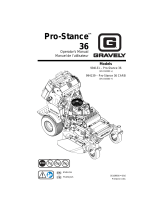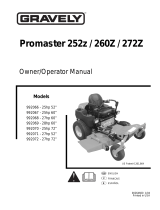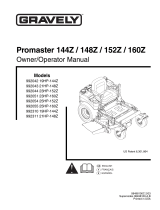
GB - 9
DO NOT operate at too fast a rate. DO NOT
change engine governor settings or over-
speed engine. Slow down before turning.
DO NOT operate in reverse unless absolutely
necessary. ALWAYS look down and behind
before and while backing.
Stop and inspect equipment if you strike an
object or if there is an unusual vibration.
Repair, if necessary, before restarting. Never
make adjustments or repairs with the engine
running.
Mower blades are sharp and can cut you.
Wrap the blade(s) or wear gloves, and use
extra caution when servicing them. NEVER
weld or straighten mower blades.
Rotation of one blade may cause rotation of
the other blades.
Take all possible precautions when leaving
unit unattended. Shut off engine. Remove
wire from spark plug and secure it away from
spark plug.
ALWAYS remove key to prevent unauthorized
use.
Know the weight of loads. Limit loads to those
you can safely control and the unit can safely
handle.
Disengage PTO when attachment is not in
use. ALWAYS turn off power to attachment
when travelling, crossing driveways, etc.
Mow up and down slopes, not across them.
DO NOT operate on slopes of more than 17°.
Use of a Rollover Protection System (ROPS)
is recommended for slope operation.
Rollover Protection Structure (ROPS) safety
precautions:
• Frequently inspect ROPS and seat
belt for damage or loose hardware.
• Use extreme care when working close
to fences, ditches, or on hills.
• Check overhead clearance carefully
before driving under any objects.
• ALWAYS wear seat belt while
operating the unit with the ROPS in
the upright position.
• Do not wear a seat belt while
operating the unit with the center bar
in the lowered position.
• Do not weld, cut, drill or modify ROPS
in any manner unless instructed by the
manufacturer.
Keep all movements on the slope slow and
gradual. Do not make sudden changes in
speed or direction.
Avoid starting or stopping on the slope. If tires
lose traction, disengage the blades and
proceed slowly straight down the slope.
Operation on slopes may lead to loss of
steering control. When operating on slopes
be prepared to react to an emergency
situation:
• Return steering levers to neutral
pos
ition.
• Immediately set parking brake.
• Turn off PTO and engine.
If you cannot back up a slope or you feel
unea
sy on it, do not mow it.
DO NOT park on slopes unless necessary.
When parking on slope always chock or block
wheels. Always set parking brake.
Use a slow speed. Tires may lose traction on
slopes even though the brakes are
functioning properly.
Do not bypass transmission when on a slope.
Tow only with a machine that has a hitch
designed for towing. Do not attach towed
equipment except at the hitch point.
Follow the manufacturer’s recommendations
for weight limits for towed equipment and
towing on slopes.
NEVER allow children or others in or on
towed equipment.
On slopes, the weight of the towed equipment
may cause loss of control.
Travel slowly and allow extra distance to stop.
Use extra care when loading or unloading
unit onto trailer or truck.
Secure unit chassis to transport vehicle.
NEVER secure from rods or linkages that
could be damaged.
DO NOT transport machine while engine is
running.
ALWAYS turn off power to attachment and
shut off fuel when transporting unit.
Keep unit free of debris. Clean up oil or fuel
spills.
This product is equipped with an internal
combustion type engine. DO NOT use unit on
or near any unimproved, forest-covered or
brush covered land unless exhaust system is
equipped with a spark arrester meeting
applicable local, state or federal laws. A spark
arrester, if it is used, must be maintained in
effective working order by operator.
Fuel is highly flammable and its vapors are
explosive. Handle with care. Use only an
approved gasoline container with an
appropriately sized dispensing spout.




















